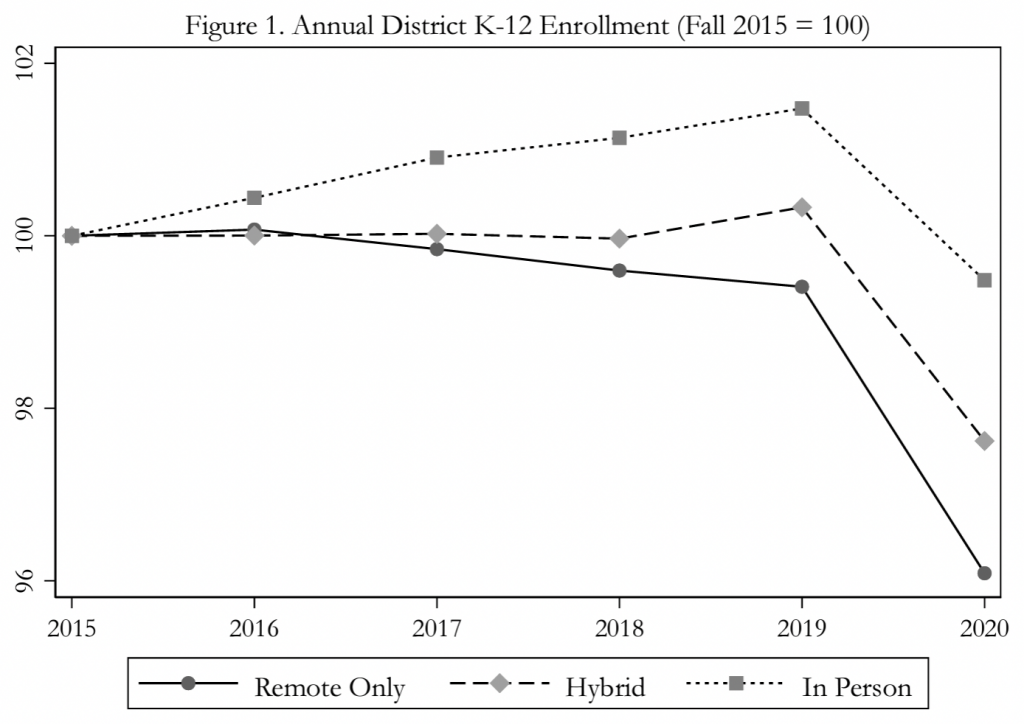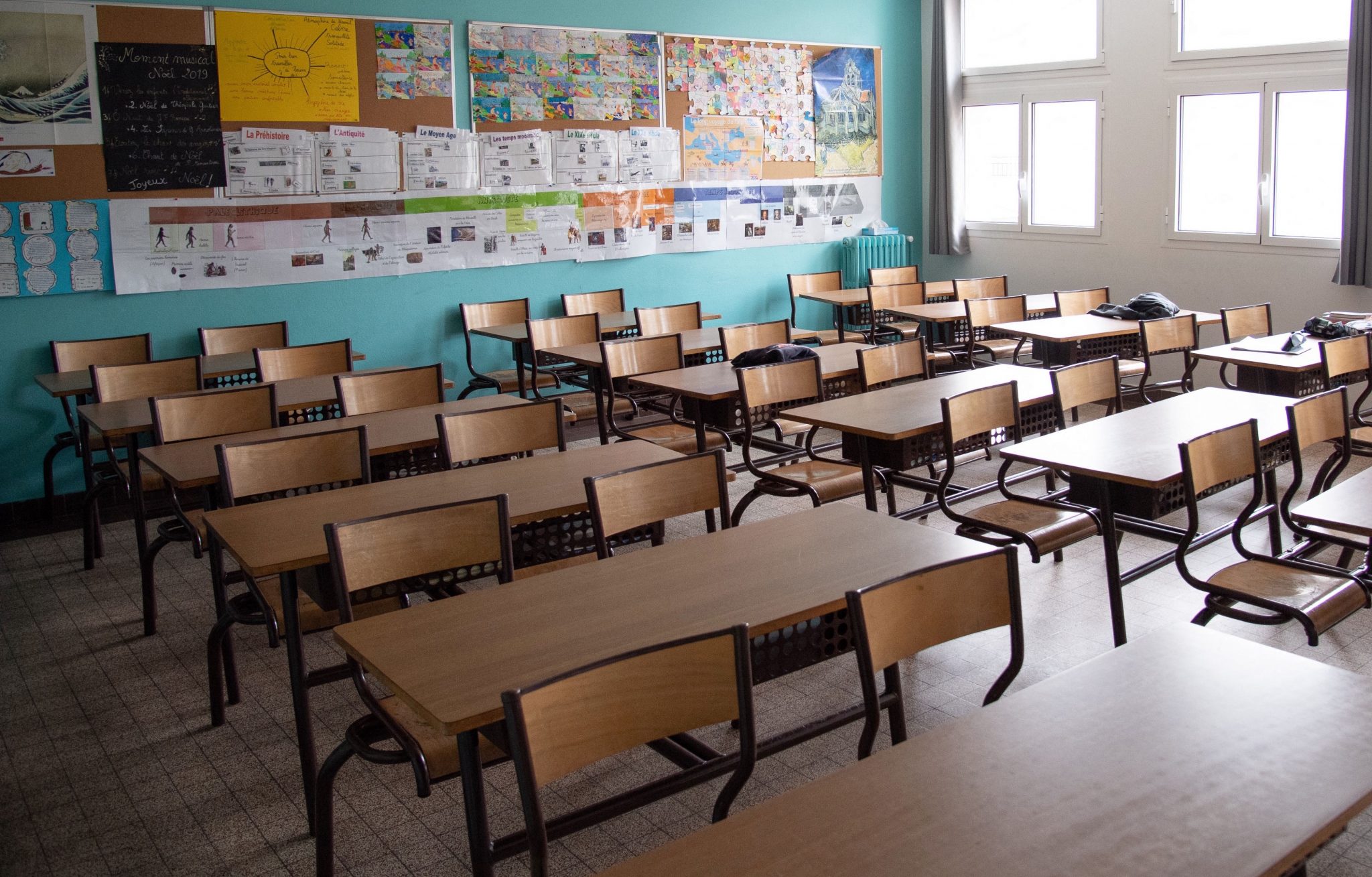We know that the switch to remote learning caused large increases in school dropout in middle-income countries like Brazil. But what about rich countries like the United States? There you’d expect the switch to be more or less seamless.
Not so, it appears. A new paper documents a dramatic decline in U.S. school enrolment last year, of which around 25% is explained by the switch to remote learning. Thomas Dee and colleagues analysed data on a large sample of K–12 public schools, comprising 17 million students across 34 states. Their main finding is shown in the chart below:

Although school districts that retained in-person learning saw a decline in enrolment, the decline was far larger in those that switched to remote learning. The authors confirmed that this finding held up in more sophisticated multivariate analyses.
Their estimates suggest that “offering remote-only instruction increased disenrollment by 42% (i.e., a change from 2.6 to 3.7%) relative to in-person instruction”. The decline in enrolment was concentrated in kindergarten.
How many students are we talking about? Roughly 57% faced remote-only instruction at the start of the 2020 school year. And about 49 million were enrolled in 2019. This means the switch to remote learning caused about 300,000 additional students to disenroll (49M x 56% x 1.1 ppts).
Interestingly, the disenrollment effect of remote learning was larger in rural areas, which may be due to a lack of high-speed internet access (though the authors were not able to explicitly test this hypothesis).
So where did all the disenrolled pupils go? As the authors note, there are several possibilities. They may have switched to private schools or home-schooling, decided to skip or delay kindergarten, become truant, or dropped out of school altogether.
The study’s findings indicate that a large number of parents did not want their children to participate in remote learning. This ‘revealed preference’, the authors note, is consistent with a report published by the National Academies of Science, Engineering and Medicine last year. It concluded that schools should “prioritize reopening with an emphasis on providing full-time, in-person instruction”.
Last year’s decline in enrolment, which was exacerbated by the switch to remote learning, may have profound consequence in the years to come. If many students do not return to the school system, they may never gain the qualifications necessary to attend college and advance in the labour market.
And if most students do return, having simply delayed kindergarten (a practice known as ‘redshirting’), they will enter an unusually large, mixed-age cohort. The members of this cohort could face large class-sizes and other challenges throughout their educational careers.
Last year, school districts across the U.S. took the unprecedented step of closing schools and instead providing remote-only instruction. Previous studies have found that the switch to remote learning caused sizeable learning losses – at least in the short run. Thomas Dee and colleagues have shown that it exacerbated disenrollment in the U.S.
Will school closures be judged as a wise policy in hindsight? The answer is almost certainly ‘no’.











To join in with the discussion please make a donation to The Daily Sceptic.
Profanity and abuse will be removed and may lead to a permanent ban.
Twenty years ago, a US academic told me that some American state universities spend the first year of students’ courses teaching them to read and write.
If he was exaggerating then, he probably wouldn’t be now.
Not really – nowadays it would be regarded as racist to teach the students things like that!
My understanding is that school closures are not really a policy at all, but are being forced on governments by teachers refusing to to return to school until various ‘conditions’ are met.
If it fits in-between their holidays and XR rebellion demonstrations/London days out.
If Reagan was president, he’d have sacked the lot and started again.
Unfortunately, the teachers union donate a lot of money to the Democrats and Biden, so that woo happen.
The fight is on we were out Reading Festival trying to stop young people getting vaccinate. Today we will be doing the same in Brighton .
That Nurse Who Asks Questions, And Encourages Others To Speak
https://www.youtube.com/watch?v=97TWeYbIdDs
stand in South Hill Park Bracknell every Sunday from 10am meet fellow anti lockdown freedom lovers, keep yourself sane, make new friends and have a laugh.
(also Wednesdays from 2pm)
Join our Stand in the Park – Bracknell – Telegram Group
http://t.me/astandintheparkbracknell
This why we need to get protesting as much as possible before it’s too late
Next events:
5.30pm Tuesday 31st August
Roundabout (County Lane/Jigs Lane N)
Outside Tesco Superstore
17 County Ln,
Warfield,
Bracknell Berks RG42 3JP
5.30pm Friday 3rd September
Loddon Bridge, (Winnersh Garden Centre/Showcase Cinema)
Reading Rd, Winnersh,
Wokingham Berks RG41 5HG
thank you for doing this!
What if everybody switched to homeschooling or private schools? One can dream!
“If many students do not return to the school system, they may never gain the qualifications necessary to attend college and advance in the labour marke”
There won’t be the need for all of those teachers either.
They’d be better off not going to college as all is does is run up huge student debts and indoctrinate another generation as Marxists.
The destruction and mayhem being injected on the educational sector is deliberate. The hokey-cokey policy shifts, open / shut, masks / no masks, all these are designed to screw with our children’s heads.
By the time these children leave school / college, barely and badly educated they will be so malleable that they really will be sheep.
They will do and say whatever they are told to.
The obedient fodder will be perfect for the NWO.
More concerning is what schoolchildren are taught once the classroom door closes.
I intensely dislike graphs that don’t show the whole y-axis.
The sole purpose of slicing off the bottom of the y-axis is to remove a sense of proportion and manipulate people into thinking: ooohhh, what a big change!